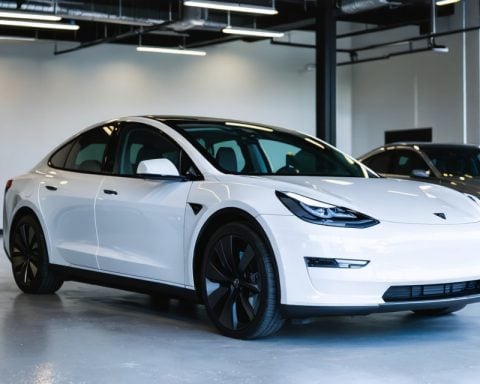- LG Energy Solution has achieved a breakthrough in solid-state battery technology that significantly accelerates charging speeds by ten times.
- This advancement results from collaborative research with the University of Chicago, led by battery expert Professor Shirley Meng.
- An innovative ultra-thin silicon layer facilitates uniform lithium deposition, enhancing energy transfer and safety.
- The research enables the development of “anode-free” solid-state batteries, reducing weight while increasing energy potential.
- This breakthrough addresses issues of uneven lithium deposition, boosting battery life and efficiency.
- LG Energy Solution aims to lead the market by combining pioneering research and manufacturing capabilities.
- This development marks significant progress toward sustainable, rapid-charging electric vehicles and energy solutions.
Imagine a world where electric vehicles recharge in minutes, not hours. LG Energy Solution edges closer to this tantalizing reality with a groundbreaking development in solid-state battery technology. Their latest innovation accelerates charging speeds by a staggering tenfold, signaling a seismic shift in energy solutions.
Concealed behind laboratory doors until now, this advancement emerged from collaborative research between LG Energy Solution and the esteemed University of Chicago, under the guidance of renowned battery expert, Professor Shirley Meng. The secret? An ultra-thin silicon layer gracing the surface of solid-state batteries. This minute alteration deftly orchestrates the growth of lithium metal crystals, promoting uniform deposition as ions settle onto electrodes. Every piece in place ensures swift energy transfer without compromising safety.
The implications of this leap are vast. LG Energy Solution’s research paves the way for “anode-free” solid-state batteries—a feat compelling in its simplicity but complex in execution. By eliminating traditional anodes, these batteries shed weight and bulk while maximizing energy potential. Historically, uneven lithium deposition hampered battery life and efficiency, yet this research provides a robust solution, challenging the norm.
The urgency is palpable. As electric vehicles and energy storage systems demand more potent power sources, marrying pioneering research with manufacturing prowess becomes paramount. LG Energy Solution stands poised to harness this synergy, eyeing a market leadership position defined by continual advancement.
In a world yearning for sustainable power solutions, these efforts illuminate a path forward. The race for the perfect battery surges ahead, and with it, visions of sustainable, rapid-charging energy become ever more tangible.
The Future of Fast-Charging Electric Vehicles: An In-Depth Look at LG Energy’s Solid-State Battery Breakthrough
How-To Steps & Life Hacks
For consumers interested in maximizing EV battery life and performance until such groundbreaking technology becomes available, here are some life hacks:
1. Optimized Charging: Charge your EV when the battery level drops to around 20% and unplug it when it reaches about 80%. This helps prevent battery overuse stress in current lithium-ion models.
2. Temperature Management: Extreme temperatures affect battery efficiency. Park in shaded or temperature-controlled environments when possible.
3. Regular Maintenance: Software updates can improve battery management systems. Ensure your EV is regularly serviced.
Real-World Use Cases
The application of solid-state batteries is limitless. Here’s how they could transform the following sectors:
– Transportation: Beyond making EVs more efficient, public transport systems like buses and trams could reduce downtime, operating more frequently.
– Consumer Electronics: Longer-lasting, safer smartphones and laptops are on the horizon with less frequent charging required.
– Renewable Energy Storage: Home solar systems might employ solid-state batteries to store excess solar power efficiently.
Market Forecasts & Industry Trends
According to a report by MarketsandMarkets, the global solid-state battery market is poised to grow from $62 million in 2020 to $483 million by 2027, driven by advancements in technology and rising demand for efficient, eco-friendly energy solutions. As tech giants like LG Energy Solution make strides, expect increased competition and innovation.
Controversies & Limitations
Despite promising developments, challenges persist:
– Scalability: Transitioning from successful lab tests to mass production is complex and costly.
– Material Costs: Silicon and other high-grade materials can drive production costs, initially making these batteries expensive for consumers.
– Long-term Durability: Although initial tests are promising, the long-term lifespan of these innovative batteries remains under scrutiny.
Features, Specs & Pricing
While specific pricing details are unavailable, solid-state batteries promise several key features:
– Weight Reduction: Anode-free designs make batteries lighter.
– Charge Speed: Potentially a tenfold increase in charging speed compared to current lithium-ion options.
Security & Sustainability
Solid-state batteries inherently offer greater safety due to non-flammable solid electrolytes, reducing the risk of combustion. Moreover, their efficiency encourages sustainability by requiring less frequent replacements.
Insights & Predictions
Experts predict that within the next decade, solid-state batteries could become the industry standard for EVs, likely replacing conventional lithium-ion batteries thanks to their efficiency, safety, and rapid charging capabilities.
Tutorials & Compatibility
While consumer tutorials aren’t yet available, industries should focus on:
– Integration Training: OEMs will require training to integrate new battery technologies seamlessly into existing EV frameworks.
Pros & Cons Overview
Pros:
– Faster charging speeds
– Safer, non-flammable materials
– Higher energy density
Cons:
– Cost of production remains high
– Fragile silicon layers may require advanced engineering solutions
Conclusion: Actionable Recommendations
For consumers:
– Stay informed about EV battery advancements to make educated purchase decisions.
– Consider the long-term benefits of newer technologies when they’re on the market.
For industry professionals:
– Engage in R&D collaborations to advance understanding and applicability of solid-state batteries.
Quick Tips:
– Regularly update your knowledge on solid-state developments.
– Evaluate potential investment opportunities in companies leading battery innovation.
For more on solid-state batteries and the future of EV technology, visit LG.












